The Riders' Blog
Catching up with TJC Elite Athlete Haley Berget August 20 2017
Show season is in full swing and TJCs 2017 Elite Athlete, Haley Berget, has been in the ribbons show after show. We decided to catch up with her at the ASAW Summerfun Show in Milwaukee, Wisconsin to see how things were going.
Luckily we caught her Pleasure Equitation Championship, which included her performance of a gorgeous pattern on a new horse to the equitation division, Impressive Assets, AKA Fergie.
Continuing her hard work and practice with Scott and Carol Matton at Knollwood Farm, Haley has been honing her form and pattern work in preparation for the big dance this week down in Louisville, Kentucky at the Kentucky State Fair World Championship Horse show.
Since this video has been shot, Haley showed in the 15 year old age division at Louisville and received a Reserve World Championship title, in a field of the best of the best!
This will qualify Haley to compete for the World Grand Championship class Thursday night! All of this was accomplished on the back of her equine partner from last year, Rosewood's Homecoming Dance, AKA Robert, owned by Scott and Carol Matton.
Congratulations Haley and Robert and good luck in the championship!
For more information on how to apply for the 2018 TJC Elite Athlete Sponsorship, click here.
First Show Down, Many Left to Go! April 24 2017
Show season is upon us!
And by that we mean that the 2017 season has officially begun for basically every region of the US. Some barns are perhaps dragging their heels waiting for their favorite “first show” and haven’t yet started their season yet, but basically every state that hosts shows has had their first of the year. Which means that the excitement (and occasional stupidity) of first show jitters is upon us all!
We decided to check in with our 2017 TJC Elite Athlete, Haley Berget, after her first show of the season and see if the horse show jitters got to her. Here’s what we found out.

Photo purchased by Berget family from Jon Mccarthy Photography.
Did you get any horse show jitters before your first show? How did you deal?
I started my season off at Mid-America Spring Fling in Madison, WI. I get very nervous for the first show - because I ride a new horse each year, I never really know how they'll act for the first show. I had a lot of nerves but I was more excited to get in the arena than anything.
How did it go?
First class he was super excited but it went well and we worked through the class. Next one we had our first pattern in the show arena, we worked through the pattern and he did super well, he was very patient and worked with me through the Good Hands pattern! I'm very proud of him and extremely excited for the rest of the season!

For more info on the Good Hands Figure Eight (and how to perform it), check out this post.
Last time we checked in you didn’t know who you would be showing. Who did you show and what's he/she like?
This year I am riding a new horse named Felix aka Snapchat! He's very young and very energetic. He's new to equitation and I'm excited for this season with him to see how he progresses in becoming an equitation horse.
After getting in the ring, what do you feel will be your biggest challenge this season in the show ring?
Since Felix is new to the whole showing scene, the hardest thing this season will be getting him used to all the noise and activity around the show arena, ultimately getting him to be more focused, and also more confident in the show arena!
What are some of the goals you set for yourself for your next show?
For my next show, my goal is to keep him balanced and to keep him calm. He’s getting very good at patterns and he listens well.
How do you plan to achieve those goals?
I plan on continually practicing, and also using more of my legs so that I can better help him with his balance and attentiveness. Experience will help him too, more shows will get him used to the noises and help him become more confident and calm.
Where are you headed next?
My next show with Felix is FASH in Minnesota from May 11th-14th and I'm excited to gain more experiences in the show ring and with him and continue his equitation career!
As You Read This... April 10 2017
...lengths of cushy waistband are being cut to size, suede knee patches are being sewn on, and heavy duty zippers and ankle clasps are stitched into each pair of jods. And very soon, pairs of TJC Elite Show Jods will (or could) be on the way to your door!
Yes, we’ve got some good news - thanks to the tremendous support we’ve seen for our presale, we’ve been able to launch production of our TJC Elite Show Jods!
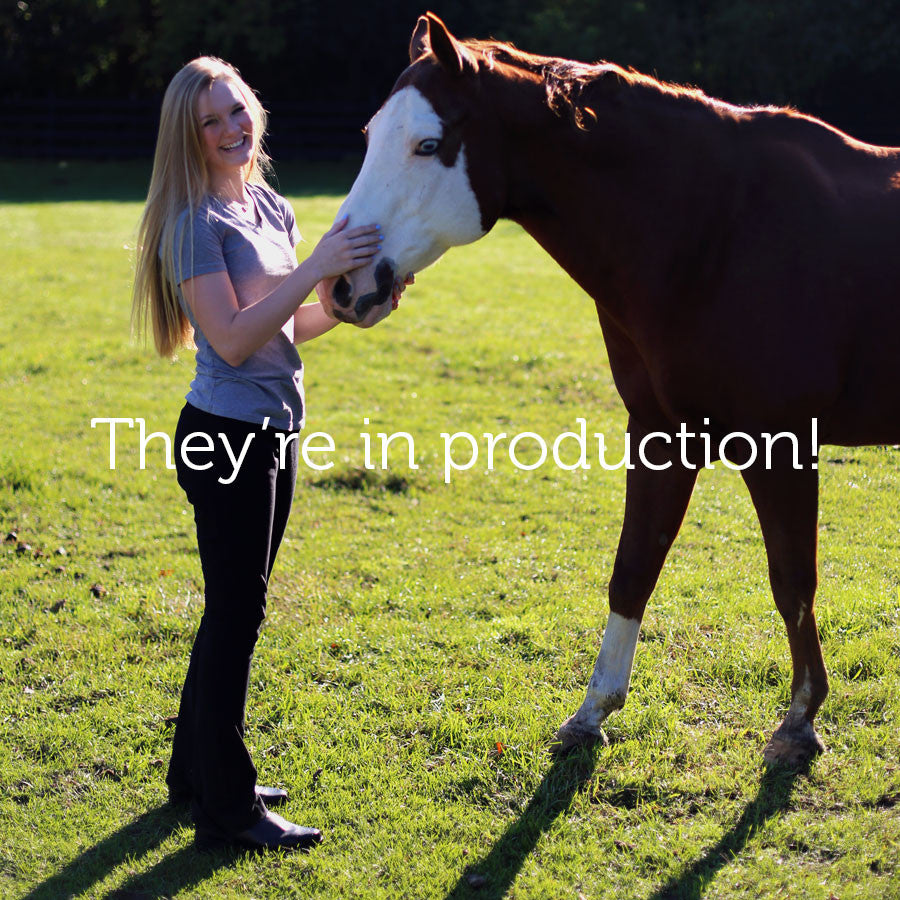
For all of us at TJC, this business is a labor of love, which means it’s a business we’re heads down on any given weekend or evening after long day at the barn (or the office). We’re so grateful for the support we’ve seen from the equestrian community during this presale. We believe that our industry’s growth is limitless as long as we work together, and we take the support we’ve seen from the community as an affirmation of this belief.
It’s beyond exciting to be able to say that, after over a year of sourcing materials and refining our pattern, our first TJC product is finally in production.
And we’ve ordered plenty of additional pairs, so you can still check out our presale page to find out more about TJC Elite Show Jods. With free returns, there’s no need to worry if you’re going to like the fit, so reserve a pair today.
My Wife's Brilliant (and Simple) Solution to a Universal Problem March 05 2017
My wife (and TJC co-founder) Lindsay works as an assistant trainer at a horse farm, which means I end up doing my share of housework. And part this housework involves doing the laundry on weekends. Every time I do the laundry for our little household, there's inevitably at least one load of jods.
A load of mud-and-shavings-covered, worn through, beat-to-bits jods.
I say this not (entirely) to complain, but rather to give some context. Because inevitably, these jods are always worn through in one place before any other: at the hem.
Why Hems Wear Through First
When I visit Lindsay at the barn, I notice that ratty-bottomed jods are the standard. Everyone - from academy riders at practice to the trainers walking the middle of the ring - wears a pair of jods with a muddy and faded hem at best, and a threadbare hem of tattered threads at worst.
The reason this happens is obvious - jods are riding apparel, and if you want a pair of jods that look long through the leg when you ride, they're inevitably going to drag when you're on your own two feet.
The Solution: Rear, Matte Clasps
Lindsay's solution was simple but elegant - a pair of black matte clasps on the back of each leg. The clasps simply snap the rear cuffs of our TJC Elite Show Jods in place while you're walking around the barn, and easily unclasp when you mount up.
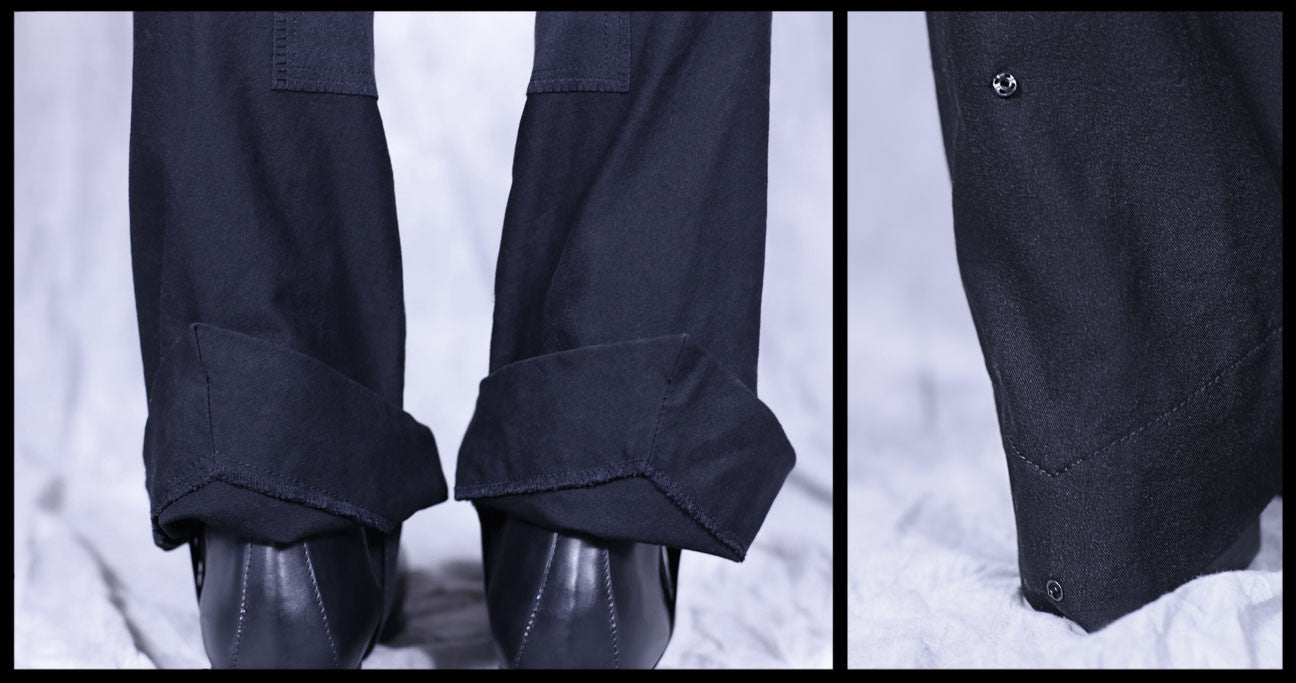
And you know what's amazing? Ever since Lindsay has started working in TJC Elite Show Jods, I've noticed during laundry days that her jods aren't ratty and full of shavings.
Over a Year in Development
As we were perfecting our TJC Elite Show Jods, we developed a handful of prototypes specifically getting the clasps exactly right. We tried everything from tie-ups (kept losing them in the wash) to magnets (which couldn't stay stuck) before settling on a simple, elegant matte black clasp.
If you (or the equestrian in your life) are looking for a pair of jods that won't wear out at the hem mid-season, then order a pair of TJC Elite Show Jods - now available in a limited pre-sale!
Three Problems Every Parent Has With Jods (and How We Fixed Them) March 02 2017

Every day, I'm lucky enough to do what I love for a living - work with horses, and people, and people who love horses. And in training our next generation of equestrian athletes, I've found that parents struggle with the same three things when it comes to finding a pair of jods for their kids.
1. Finding the right size
Every child is different. This fact is obvious, but kids' clothes rarely take this into account. Which is why we made our TJC Elite Kids Show Jods in fifteen sizes, with extra length in the hem of every pair to help you with any of those sudden growth spurts.
2. Finding a fair price
Because children are always growing, we can't spend an arm and a leg on their jods. We're committed to pricing our products fairly, which is why our kids' jods cost 25% less than our adults' jods.
3. Finding a quality product
Even though kids are going to outgrow everything, you want to make sure their jods last a full season. Which is why the TJC Elite Kids Show Jod has the same features as our adults jods - stretchy but durable fabric, heavy duty YKK zipper and clasps and a full suede seat. In a classic style and color, they're perfect for academy shows.
After spending over a year working with manufacturers, we're currently offering TJC Elite Kids' Jods in a limited presale, and we need your help to turn them from a prototype to a product. Check them out here.
Announcing the TJC Elite Athlete Sponsorship Program February 27 2017 3 Comments
We believe that riding is a sport. And like any other sport, equestrianism takes a ton athleticism, talent, smarts, and most of all, hard work.
So given that riding is a sport like any other, why are equipment and apparel endorsements or sponsorships so few and far between for our industry?
We feel like there’s no point complaining about a problem if you’re not going to do anything about it. So not only are we introducing our new TJC Elite Show Jods in a glorious Pre-Sale (shipping early Summer 2017), but we’re also introducing our TJC Elite Athlete Sponsorship Program.
Each year at the close of show season, TJC will be accepting applications for sponsorship, because we believe that athletes that need, want, and strive for the best should get it!
Some of the amazing perks are:
- Becoming the face of TJC: along with other perks, you will be participating in product shoots, web and social content and our advertising campaigns, because what ARE we without our athletes and equestrians?
- Advertising budget: any of YOUR ads for the year will be subsidized by TJC. We want it to be known that you were chosen, out of hundreds of applications, to be called a TJC Elite Athlete.
- Swag: the best part of any sponsorship is the swaaaaaaaaag! Our TJC Elite Athlete (you) will be provided with one free pair of TJC Elite Show Jods, every two months! That’s means six pairs for the season (a value of $720.00 USD).
- Resume building: athletic sponsorship, like a scholarship, shows you are serious about our sport (like we are) and that you’re professional enough to garner the support of more than just your parents and friends!
As this year’s show season draws to a close, keep an eye out for an announcement that we’re taking applications for the 2018 season. For now, though, we’d like to announce our first sponsored athlete.
The 2017 TJC Elite Athlete
This year’s sponsored athlete (and face of our TJC Elite Show Jods) is Haley Berget, riding out of Knollwood Farm in Hartland, Wisconsin.
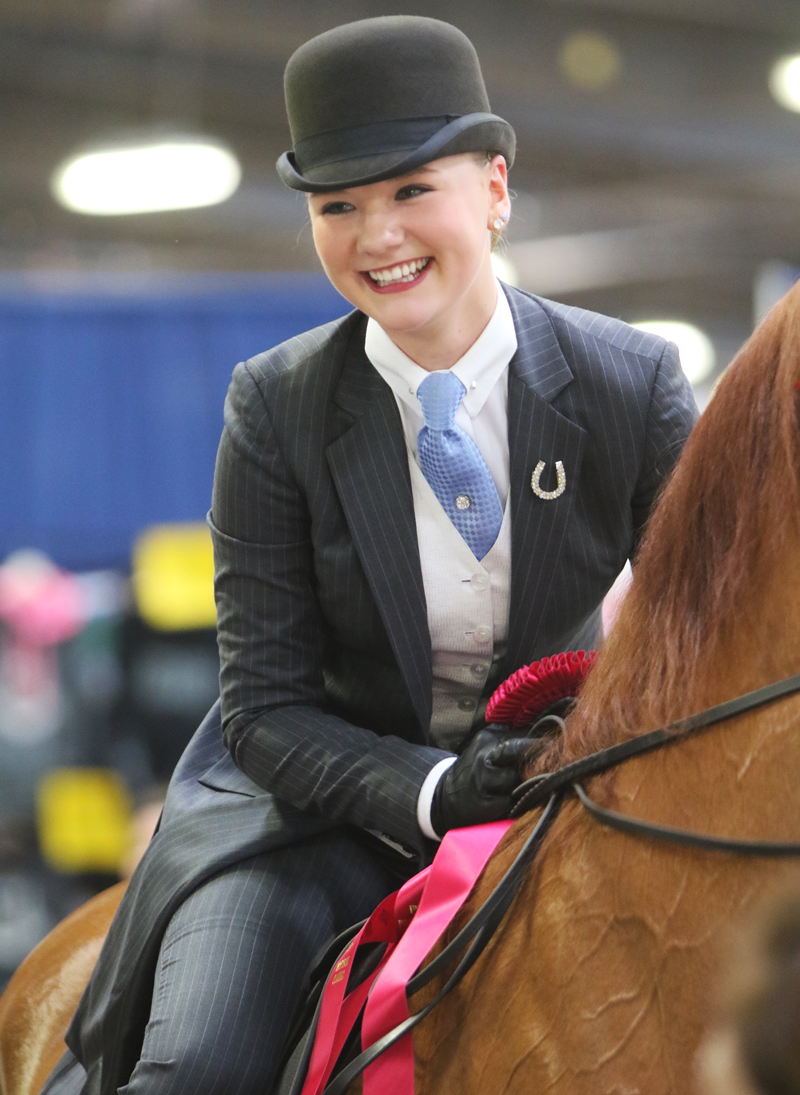
Meet 2017's TJC Elite Athlete February 27 2017 1 Comment
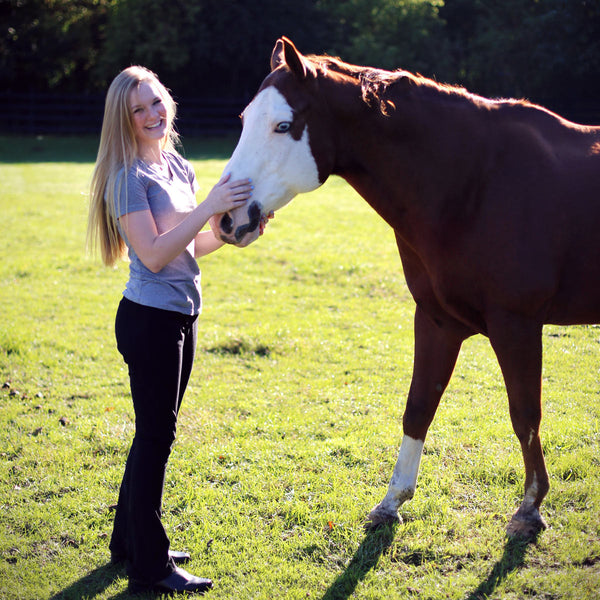
We are beyond excited to introduce to you and the world, our 2017 TJC Elite Athlete: Haley Berget. Haley represents so many of the things we love about the equine industry: passion, dedication, joy and grit. We sat down with Haley and talked to her about her sport.
What type of riding do you do?
I ride Saddle Seat and the American Saddlebred 14-17 Pleasure Equitation where the judge judges me on my form while riding.
Horse riding on the whole is a big industry in the US, but saddle seat is only a small piece of the market. If someone is interested in riding and don’t know what kind, why would you encourage them to ride saddle seat?
Saddle seat is so different from everything else, in many ways because it is a smaller industry. We’re all a family, everyone is super nice and there’s a great sense of community and support so it’s an awesome environment to grow up in.
A lot of folks who don’t ride think of as more a hobby than a sport. What would you tell those folks?
Horseback riding is absolutely a sport, in fact it’s more of a team sport than most people realize, because you’re working within a team, you and the animal. The horse has its own will and its own emotions. You’re teammate is big and bold. You have to bond with your horse like you do with, say, your soccer team if you want to perform well. We put in a lot of time to get that bond with our horse and get our form and physical fitness together to perform our best. I’m even homeschooling this year to ensure I can put the time and resources into practicing and ensuring I can perform at my best for my partner.
How many times a week do you ride?
I ride at least six times a week, usually two-a-days, three days per week.
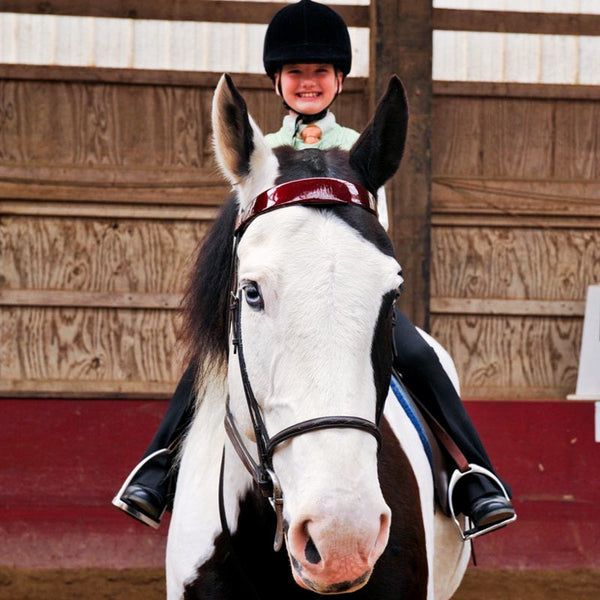
How old were you when you started riding?
I was seven when I started riding seriously at Knollwood Farm, but I started “riding” practically when I was born at my cousin’s farm. My mom would hold me and we would walk around then she would run next to me while we trotted. My earliest memory of being on horseback was on my cousin’s mini horse. I always remember trotting and trying to get it to canter around the pasture, but instead it would just run away and do what it wanted to.
Who are your biggest fans?
My parents and family for sure. My aunt and uncle always call me after every show and ask me how it went. My parents do whatever it takes for me to get out to the barn or get me into the show ring. They will do anything for me which is amazing
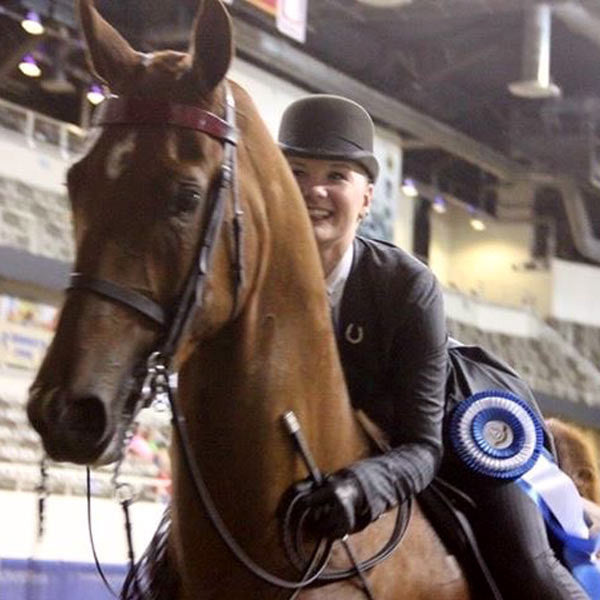
Who is your Equine Partner and what are some of their challenges?
Robert aka Rosewood’s Homecoming Dance was my 2016 partner. He was new to the whole equitation scene so he sometimes had his own ideas about patterns or the class. We just worked through it!
We understand that you don’t know who you’re riding yet for 2017. How are you feeling?
It’s kind of scary not knowing, but it’s fun to ride a new horse each year and have the challenge of learning a new horse each year since they are all different, but learning a new horse and meshing with them at the end of the year is a great feeling.
What are some of the biggest challenges in improving yourself and your ability?
When I first started riding I wasn’t very confident in myself. As I continue to ride I’m becoming more confident. I still have a couple things to fix, like my toes and being more pushy, but now I’m able to handle it and let my horse do what it needs to do.
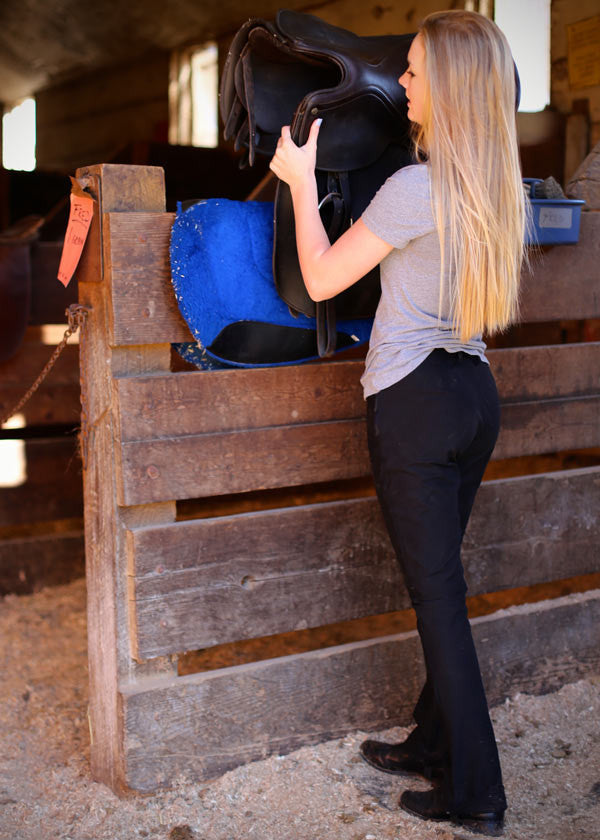
This year you’ll be riding in TJC Elite Show Jods. How they feeling so far?
I love them, they’re super comfortable and easy to ride in. They’re really nice and fuzzy on the inside which is great for gripping the saddle.
What are some of your riding goals for 2017?
A good year is finishing all your classes in one piece, and feeling on the most part like you had good rides. A big goal for me is making my trainers happy. I don’t care about the ribbon, but I want them to be happy with my ride and how I control the horse.
What motivates you to keep riding?
I’m always motivated to just do better than my last ride. That keeps me motivated to keep progressing and getting better.
What is your most special riding memory to date?
I always remember when I rode Nugget (Diamond Market) in 2015. That year I won a national championship in an 18 and under class as a 13-year-old and one of the youngest people in the class. I’m still in shock that it happened. I was shaking and crying with happiness, but it’s a memory that keeps me motivated.We Made Our Own Jods! February 24 2017
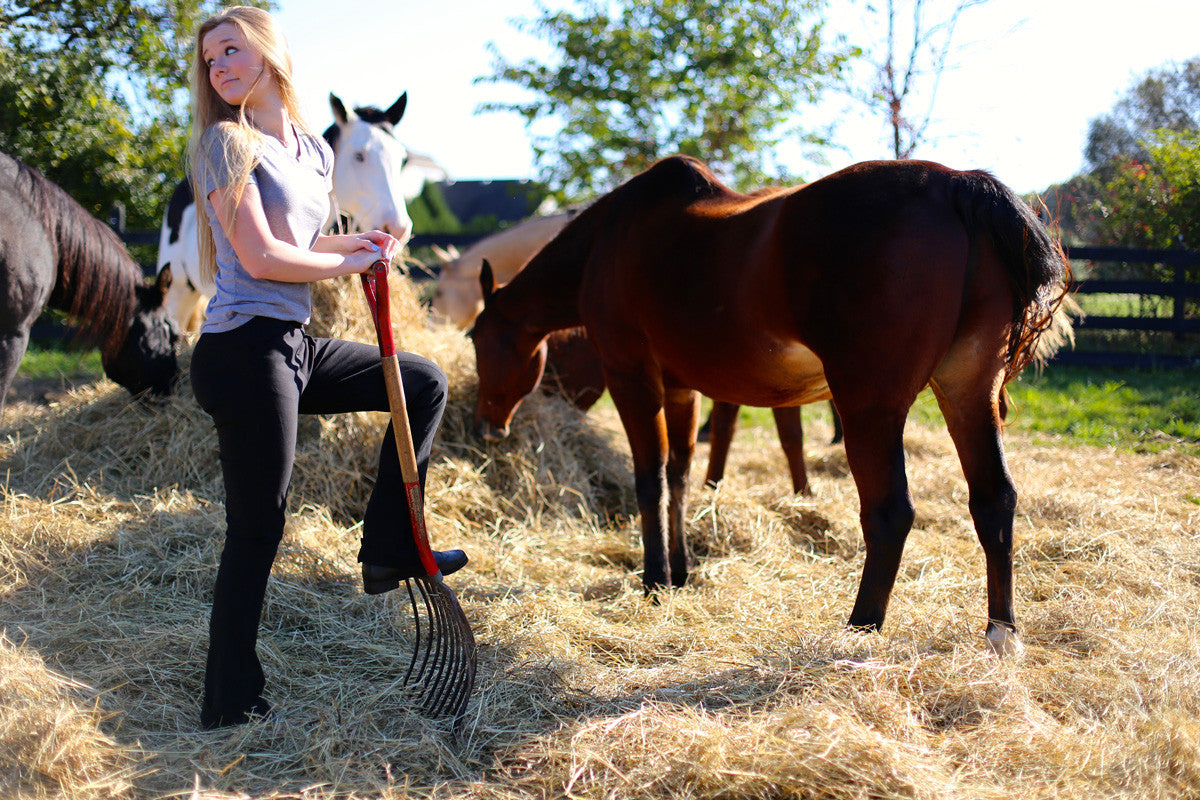
Hello again TJC and equestrian family! You may have noticed that we’ve been pretty quiet for the past year.
Well here’s why: we’ve been gathering samples, tracking down accessories and testing fabrics and textiles from dozens of manufacturers to design and create the perfect riding jod, and now we need your help to bring them to market.
But first, let’s talk about the jods.
As a trainer, I’ve consistently struggled to find a pair of jods that perform as well on the ground as they do in the saddle. Anyone who either rides seriously, or works with their horses outside of just lessons and showing, will agree that finding a pair of jods that can stand up to the abuse of riding multiple horses a day, cleaning stalls, driving around on a tractor, and stacking hay is the absolute center of their dreams (and sometimes nightmares. You know….the kind where your jods split down the middle in front of everyone).
Our TJC Elite Show Jods are focused on solving the five biggest problems we have all experienced with jods for as long as we’ve been wearing them.
There’s Always Been a Tradeoff in Fabric (Until Now)
Durable yet uncomfortable fabric, or comfortable but easily destroyed - we’ve all faced that decision, right? We’ve all put our legs in those scratchy, unbreathing, yet unrelentingly durable polyester jods. Bleach doesn’t even make them bat an “eyelash,” but holy moly are they the worst. They don’t move with you and somehow they make parts of your legs sweat that you didn’t even know could!
OR you show up to the barn in your glorious, soft and stretchy jods, when you decide to casually perch yourself on a hay bale to talk about how awesome they are and POOF 8 massive holes in the butt area showing just how pink your underwear really is…. The TJC Elite Jod is meant to find the happy medium between these two. The Poly/Cotton/Spandex blend has the durability of those bomb-proof 100 year old polys in the bottom of your drawer, with the comfort, breathability and flexibility of those spandex jods you threw out after one or two uses.
A Waistband That Digs In (or Flops Around)
Nothing feels quite as awful as trying to swing your leg over a horse with the waistband of your jods turning all those important internal organs into porridge. Alternatively, there’s nothing quite like having to deal with the glory of having to stop during your lesson just to pull your jods up because your waistband doesn’t really know where your waist is! The TJC Elite Show Jods have a thick yet soft elastic waistband, which makes these jods feel like a custom fit in the waist. Not only does it stay put (so no plumber crack incidents) but it doesn’t cut into your sides while you work or ride, making them the perfect pair for all day use.
Flimsy Accessories
There’s nothing like the zipper busting out or the clasps/buttons randomly exploding off your jods so the only thing holding them up/closed now is a safety pin or two (if you can find one in your barn...for some reason I never can). TJC Elite Show Jods have been equipped with heavy duty YKK zipper and clasps. Meanwhile the inner zipper paneling is made of super soft microsuede to ensure your skin never feels just how heavy duty that zipper is! No more having your trainer call a timeout in the middle of your class just to tape your zipper closed or paint your hip with hoof black (not even kidding).
Frayed Jod Bottoms
Listen, we all have jods that we have been dragging around the barn, tearing and fraying the bottoms, that we will never throw out because we still love them and don’t care, but why not love your jods AND keep them from looking like you’ve been cursed to slowly turn into a mummy! Each pant leg of the TJC Elite Show Jods is equipped with a pair of discrete metal snaps to keep your pants from dragging around while you’re working on the ground, but also to allow you to roll them down with ease when you’re ready to mount up! You also no longer have to keep track of your tie-ups at the show, since those go missing every other show.
(Bonus) Free Shipping and Free Returns
We all know how hard it is to buy jods online. We, here at TJC have been working to try and solve that problem. Even as a storefront for other sellers, we found it hard to be able to access inventory for our customers to get you the jods you need, when you need them. So with our new venture of the TJC Elite Show Jod, our Free Shipping and Free Returns policy still applies, because you shouldn’t HAVE to just by jods at shows or in a store and you shouldn’t have to feel like you’re being penalized for returning a pair of jods that weren’t the right fit.
You Can Help!
After over a year of design and development, we’re confident we’ve built the last pair of jods you’ll ever need to buy. But we need your help to turn them from a prototype to a product. You can help us do so by checking out our TJC Elite Show Jods Presale, sharing it with your equestrian friends and family, and (if you’re as excited about these jods as we are), by buying a pair or two for yourself.
Seven Steps to a Perfect Pattern July 29 2016
You had the best equitation class of your life. The transitions were smooth, your horse never broke or missed a lead, and you had perfect ring position the entire time. But before you can head to the winner’s circle, you have to nail the pattern. In any competitive equitation class, a clean pattern can make or break a rider. Leaving the lineup for a solo can be scary, but with a little preparation and some expert advice, it’ll be a breeze. So here are seven tips to help you nail your pattern every time!
Practice on the ground or with a school horse
If you’re lucky enough to get your pattern ahead of time, then take the opportunity to practice! Whether it’s on the ground with your trainer or with a lesson horse, practicing will help you memorize it and feel more comfortable. While warming up, practice a few of the elements with your show horse so that you can feel more confident before heading into the arena.
Visualize your pattern
If you have the pattern beforehand or not, visualize yourself doing the pattern as the announcer is reading it off. Mark out spots in the ring where you will make you transitions and use this time to reinforce the pattern into your memory.

Get your horse focused
After standing in the lineup for a few minutes, it’s easy for your horse to get distracted or think they’re done for the day. Take some time before your number is called to bridle them up and get them focused again. Trot in small circles while you’re on deck to soften up your horses mouth, get them bending and reengaged with you.
Calm down
This is important for both rider and horse. If you have a greener horse, talk to them and pet them before leaving the lineup. Some younger horses get nervous when they have to leave behind their friends in the lineup, so make sure to comfort them through the process.
Remember to relax and take deep breaths. And trust that you can do it!
Take your time
Many nervous or novice riders tend to rush through patterns, but the key to a successful pattern is patience. Before moving on to the next element of your pattern, pause and wait for all four hooves to be on the ground. This shows the judges that you completed one element and are moving onto the next. It also gives you and your horse time to prepare for the next section of the pattern.
Miss a lead of diagonal? No big deal!
Even the best equitation riders will screw up sometimes, but it’s how you recover that matters. Calmly correct yourself as soon as you realize you messed up. Most judges will give you credit for recognizing a mistake and fixing it. No matter what happens though, end your pattern with a smile to show good sportsmanship.
Finishing touches.
After nailing your pattern, halt after completing it (unless told other wise) and subtly look at the judges to let them know that you’re done. This finishing touch shows that you know exactly what you’re doing and have thought through your pattern from beginning to end. And don’t forget to smile, because this is all about having fun!
Keep these tips in mind and you’ll be a pattern pro in no time!
About the Author: Anne Thurber is founder of saddleupconsultants.com and People's Choice Morgan Reserve equitation ride of the decade, 2001-2011.
The Five Hardest Things for an Equestrian Parent (and What to do About Them) June 08 2016
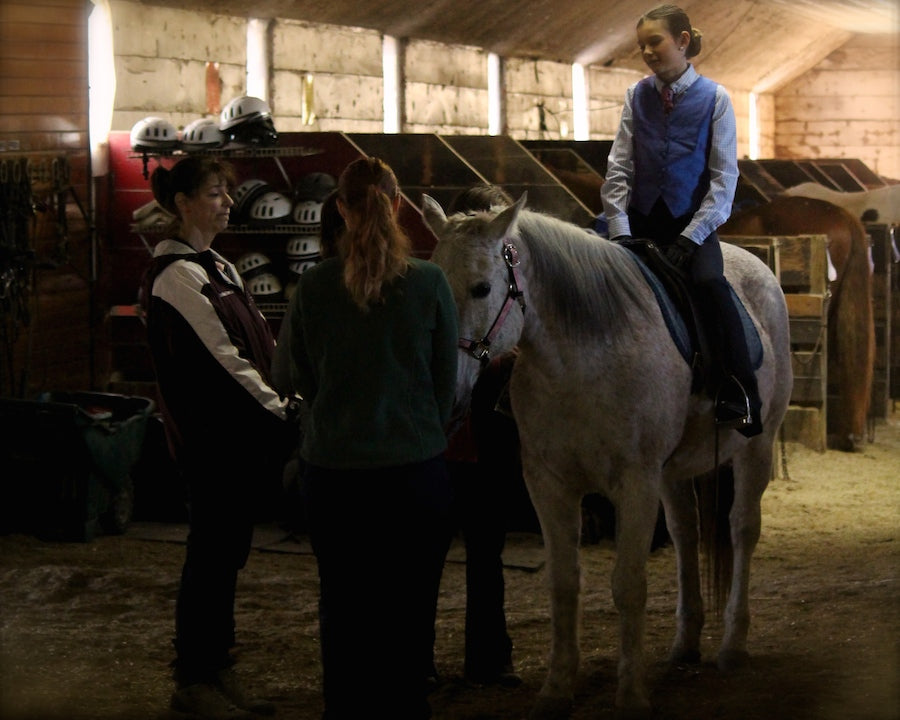
Young riders should (hopefully) love and appreciate our parents to the ends of this earth for giving us the opportunity to study the art and sport of equestrianism. While as riders, we're always aware of our own hard work, it's often easy to forget their struggles as an equestrian parent!
From watching helplessly as kids miss out on (seemingly) well-earned ribbons to pushing a little too hard, here's a few things equestrian parents struggle the most to overcome, and what to do about them.
Watching their kids go through a slump
While anyone can understand wanting to get involved in the learning process when your children are clearly struggling to improve/understand, you actually do your little equestrian more harm by inserting yourself into their learning process. Bad lesson after bad lesson is a difficult thing to sit through and picking up the emotional pieces in the car on the way home from the barn is an even MORE difficult thing to deal with, but the lessons your child learns about riding and life by getting through it with their instructor are empowering ones that carry through to their high school, college, and adult years.
Watching their kids get dissed in the show ring
We all know how hard our kids work to get the job done. We are very close to where they started and how far they have come. We appreciate their abilities more than anyone so it is heartbreaking to watch them absolutely kill it in the show ring and get totally dissed for no apparent reason, but as we mentioned before, sportsmanship is important and sometimes when we deserve to win, we don’t. And sometimes when we don’t deserve to win, we do, so help your little equestrian understand that the most important thing is what their trainer thought of their ride and try to save those disappointment feelings for when your little equestrian has headed off to bed.
Not “getting it”
Sometimes equestrianism is hard to understand. It’s not a timed event (always) that has a “clear winner.” Judgements that result in a win or a loss are often subjective, which--for parents that are more used to team sports--can be a hard pill to swallow. While it may make absolutely no sense, it is so important that we support our little equestrians because that is actually one of the biggest life lessons equestrianism teaches; life is not always fair.
Pushing their kids too hard
Just like in any sport, motivating your little one to do their best is a great thing, but setting your personal sights to high will not only lead to disappointment for you, but for your little equestrian. It’s also likely that those unachievable standards will put a great deal of pressure on them to the point that they don’t even enjoy it anymore. Emphasizing the importance of commitment and practice to succeed are great things equestrian parents can do, but telling your little equestrian that it’s make or break, do or die, and sentiments of that nature, will just make them feel the opposite of supported!
Watching their children get hurt
While it is entirely understandable to watch your baby fall off and SCREAM like a banshee, running into the ring is actually one of the worst ideas. Rushing to your little equestrian’s aid is your natural instinct, but getting in the middle of a situation involving horses and potential for serious medical assistance when you can provide, neither medical assistance norhorse assistance, is not the best course of action. That’s not to say you shouldn’t be involved and head to their aid if you are needed, but taking cues from doctors and trainers is best as your frantic presence will likely only worry your child more. Keeping calm and following the advice of the professionals who have seen it, done it, and handled it before is always best. Besides, if you are lucky enough to watch your kid fall off and get up completely unharmed, they will have the opportunity to learn the age old adage “get back in the saddle” with their trainer; something that every rider must learn at some point or another.
Are you an Equestrian Parent that’s struggled with any of these things? Let us know in the comments below how you overcame them!
Your Guide to America's Horse Rescues May 15 2016 10 Comments
Have you ever felt the deep pangs of terror we all come across when we sell a horse? That feeling of doubt, despair, and helplessness in the uncertainty around whether they are truly going to a good home? It’s not that you didn’t do your research on the buyer and assess them as a certainly worthy individual; it’s just that you don’t know what will happen after them, or the owner after that if it comes down to it. Horses are a massive financial undertaking and you never know what circumstance could arise that might displace your beloved equine friend out of their worthy new owner’s hands, into the ownership of someone that wants to “turn them over for a quick buck.” Especially considering some circumstance has pushed them out of your very hands!
The great news is, there is a vast network of rescuers are constantly working to rescue, rehabilitate, and repurpose horses that find themselves in the worst case scenario. As a horse person, it is a far better outcome to have your horse with you till their dying days, which will of course be when your horse is like 67 because they live forever and ever and ever! But for the times when circumstance takes over, surrendering your horse to, or working with a rescue—many of which insist on giving the horse back to them if, for some reason you are no longer able to give that horse a home—to rehome them is often the best option out there.
On the flip side of that coin, much like adopting a dog, rescuing a horse can be a vastly rewarding, unending source of joy as a horse owner. You can find the best horse you could’ve ever dreamed, discarded and broken from buggy life, or a family pet who’s owner’s health forced them to send their beloved equine friend to be rehomed. Whatever the back story, there is a rescue out there to suit your needs!
For that reason, here at TJC we decided to put together a (somewhat) comprehensive list of horse rescues in the USA. This is a constantly changing, interactive map that we are able to add to so if you know of a rescue we missed, please reach out! Be sure to also share. In doing so you may inadvertently inspire someone to find a repurposed horse for their program, or someone to work with a rescue to rehome a horse they are no longer able to give the time they need to it.
If you're having trouble viewing the interactive, click here to view the fullscreen version.
Have you ever adopted a rescue horse or had to work with a rescue to rehome one? If so please share in the comments down below!
Seven Killer Off-Season Interval Workouts for Equestrians December 02 2015
If you're like me, the off-season kind of looks like this. You manage to ride and/or workout pretty much every day in October. November rolls around and you still manage to get out there every second day. By the holidays, you're lucky to work out once a week. You rally after New Years', but it's always an uphill battle to get into show shape by the Spring.
There's an air of inevitability about this, but there doesn't have to be. Winter is cold and dark, and it can be a struggle to schlep your way to the gym - so here's a full week's worth of at-home (or at the gym) workouts for any equestrian looking to get fitter in the off-season.
1. Butt Day
That's right, it's butt day. If you want to sit the canter without bouncing around in the saddle like a sack of potatoes, strong glutes are a must. So here's a quick interval training workout you can do to strengthen your butt, with no equipment needed.

2. Upper Body Day
Riding is surprisingly demanding on your upper body. And your back and obliques are particularly important for keeping your posture on point as you ride. This workout is pretty demanding, so make sure you take short breaks during sets if needed. Prioritize maintaining good form over doing exercises quickly.

3. Sweaty Cardio Day
Full disclosure: this workout is pretty real. It'll run for about 30 minutes, and you'll be struggling pretty much the whole time. BUT it's a full body workout and it'll burn a ton of calories. And as with any other tabata or anaerobic workout, you'll keep burning calories for up to 24 hours after you're finished.

4. Lower Back Day
Great news! You've earned a day off. Everyone needs at least a day or two off every week, even total workout monsters. And if you've been working out and riding regularly, chances are your lower back gets pretty tight. This is a nice, easy stretch and light workout to help loosen up your lower back.

5. Core Day
For any rider, strong core muscles are a must. They're the difference between a rider who looks (and feels) in control, and a rider who looks like a piece of overcooked linguini. And as countless infomercials have probably told you, crunches are boring. So here's a complete core workout that's far from boring.

6. Arm Day
You don't need John Cena's meaty cannons to ride a horse. But you do need the muscular endurance to keep your arms firm but relaxed throughout a ride. This interval training workout will help you strengthen and tone your arms without adding bulk. And once again you don't need any weights, just some space at home or the gym where you can jump around safely.

7. Leg Day
Nobody likes leg day, so we decided to leave it til last. But that doesn't mean you should skip it - strong thighs and hamstrings will help you look solid as a rock with they finally add a section of no stirrups in the senior eq championships leading up to the finals (thank the Lord!).

Keep Your Eye on the Prize
Remember that show season of 2016 will be on you again before you know it, and you want to be in tip-top shape when it arrives. When you start next season in tip top shape, you'll be glad you put in the effort over the winter.
Got any at-home workouts to recommend? Let us know in the comments below!
How to Say Goodbye November 25 2015 1 Comment

The end of the show season is upon us and that means one thing: we are all saying “goodbye” to something. Be it the show season of 2015, your junior exhibitor years, or even your equine partner, there is nothing like saying “goodbye” to make you want to crawl into a hole and hide until you just don’t have to say it (if only that worked)!
Unfortunately, real life doesn’t offer such a solution. So instead, we have to find a way to deal. Here are five ways to help you say “Goodbye”:
Stay involved
If you are a junior exhibitor and you're aging out, you probably have a lot going through your head… things like, I will never have another horse; how will I compete as an amateur; I may never see the inside of a barn again!
Well, stay calm and get involved! All of these are potential outcomes of you aging out. You may never have another horse. You may have a hard time competing as an amateur. You may never see the inside of a barn again. But that’s only if you let those things happen. If you stay involved in the industry, no matter what capacity, I guarantee you will end up in a barn again. As for having a horse and competing as an amateur, those are great goals for your future! Don’t just take those potential outcomes as guarantees and accept defeat. Stick around and you will find more opportunities to participate in ways you never thought you’d enjoy.
Think of the positives
While there is literally nothing more devastating than having to say “goodbye” to an equine partner, there are ways to cope with that feeling of loss. Start by thanking your lucky stars that your equine partner isn’t dead and is in fact about to find another rider that needs the many lessons your partner taught you to become a better equestrian. Focus on the fact that you loved your equine partner enough to be totally wrecked at the thought of selling them, which means that you KNOW their new human partner will love them just the same (and definitely spoil them with peppermints). This type of change also means you have something to be proud of as a rider. You have (hopefully) worked hard over the past few years with your equine partner and the fact that you mastered them and need new challenge is something you ought to be proud of. Keep an eye on those silver linings!
Prep for 2016
If you just hate the off-season like the rest of us (excluding the professionals who are loving some downtime right now), start prepping for the 2016 season. While many are winding down the number of rides they have a week, ramp it up! Participate in No-Stirrup-November and get in the saddle as often as you can. This will give that sense of working toward something rather than being stationary; a common feeling when the season ends.
Reflect
While moving forward and moving on are important parts of getting past that “goodbye” feeling, reflecting on all you have accomplished or done is an important part of understanding why or how you would best like to say that dreaded phrase! There’s either a lot for you to be proud of or a lot for you to work on so whether your “goodbye” is bittersweet or a huge relief, make sure you take a look at what you did this past show season and think about how you can do it better next year!
Be thankful
Above all else, be grateful for the opportunities you have and have had that have put you in the position of having to say “goodbye.” It isn’t the average kid, teen, or adult that gets to spend their free time with the amazing and impressive creatures we are lucky enough to call our friends, our partners, and our pets; horses.
Have any tips to ease the “Goodbye” pains? Share in the comments down below!
How to Bounce Back from a Disappointing Show Season October 14 2015
For almost any breed, horse show season is coming to a close. Most people have a handful of shows or competitions left to go, or have just come home from their final hurrah. But if you didn't quite achieve everything you'd wanted going into the season, how do you bounce back?
There’s nothing worse than feeling like you came short of your goals or let you, your horse, or your trainer down. But here’s the good news: there are a few easy things you can do to dust yourself off emotionally, and get back in the saddle - both literally and figuratively.
Don’t dwell on the bad moments
While you want to take lessons away from all the mistakes you made this season, don’t take screenshots of the mistakes in your class videos and post them on your ceiling so when you go to bed at night you are staring at a collage of failure. That is:
- great way to get no sleep at all, and
- a great way to pull yourself deeper into the dark rabbit hole of a riding slump.
Just take those moments, learn from them, and move on!
Make a plan
Often when you fail, it’s a catalyst for reaching greater heights. You are forced to take a look at what went wrong, or what is holding you back from achieving your goals. So make a plan to figure this roadblock out if you haven’t by spending time discussing it with your trainer. Or if you HAVE figured it out, make a plan for how to get around that roadblock; or kung fu kick the crap out of it till you entirely clear your road to excellence!
Hit the gym
Get your butt into the gym (or outside if you prefer) so you can get yourself in good physical shape. Nothing makes you more motivated or re-energized than feeling like a lean mean riding machine! Pick a reasonable starting goal, like getting to the gym 2-3 times a week to start off with and continue raising the stakes. Run a 5k, do a triathlon if you’re really motivated, and if you’re insane, do something like Tough Mudder where they make you go through a cold and muddy obstacle course that is long enough to make you question whether or not this was a good idea and whether or not you will actually survive. Whatever it is, get to work!
Hit the barn
While you are working hard on your plan for improvement and your physical strength and wellbeing, don’t forget to spend time with your horse, your trainer, and - in fact - as many different horses as you can. This will ensure a well rounded training experience over winter and really help you be a more capable, more adaptable rider; something that often causes roadblocks for riders.
Look to the future
Get yourself excited about the upcoming show season as an opportunity for redemption. Don’t dread it as a potential round two of failure served up with a side of sadness, because then you'll never be able to motivate yourself to do the work needed to get back. Take the time to really think about why you love the sport you are in and fall back in love with it if you’ve lost sight of that. Nothing is more motivating than passion so make sure you haven’t lost yours!
Have any stories about an embarrassing show season and how you got back into the saddle? Let us know in the comments down below!
The Five Reasons Cleaning Stalls is Actually The Best September 16 2015 4 Comments
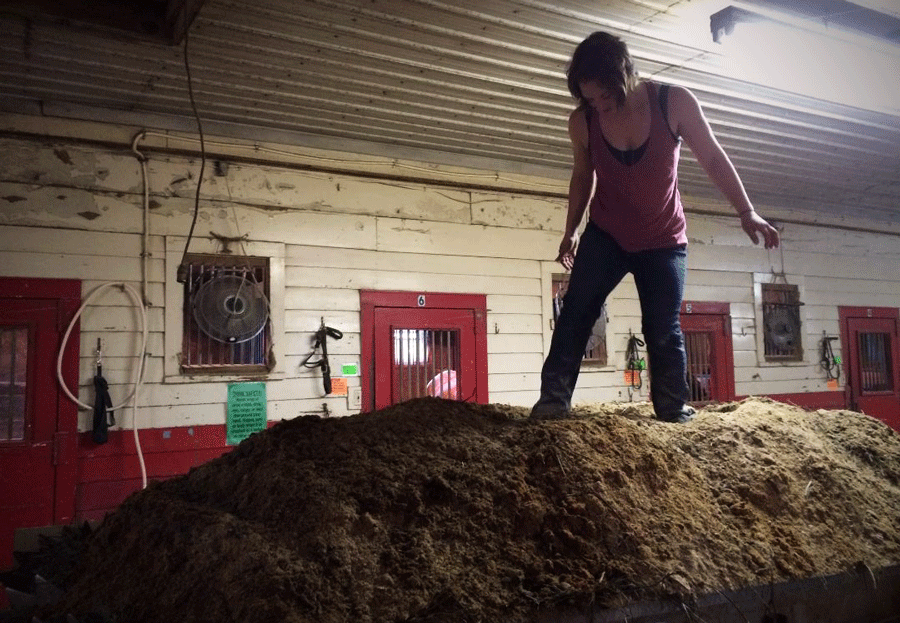
As equestrians, we are all familiar with the unfortunate task of cleaning stalls. It’s physically hard, it smells, and the smell inevitably sticks to your clothes and boots (not to mention you yourself - like an equine stink bomb). But what we don’t often think about are the many advantages to spending your mornings cleaning stalls! Let's look at a few.
It gets you IN SHAPE!
As we've written about before, horses make us as humans healthier. You burn about an average of 422 calories per hour cleaning stalls…. 422. Move over treadmill! Not only does it elevate your heart rate to the optimal fat burning level, but it also tones the crap (haha) out of your shoulder and arm muscles, while shaping up the most important riding muscles of all, your core.
It let’s you know your horse's’ habits
If you are a professional, be it a professional horse trainer or someone that just has a job outside the horse industry, you probably don’t have a ton of time to just sit around and get to know EVERY horse that crosses your path on a deeper level. But here’s the thing: what your horses do in their stalls is a definite indicator of why they do other things in the arena. While we all know that a rare horse will be absolutely NUTS in their stall and a complete angel in the arena, cleaning your horse’s stall will let you know about their eating habits, if they need toys like jolly balls to keep them entertained, or if they need some more outside time.
It’s great time to think
While you may have a really busy day ahead of you or a horrible day still lingering in your mind, there is no time like stall cleaning time to meditate your way through whatever is bugging you. Let’s face it, sifting through shavings for poop nuggets and pee spots isn’t exactly MENTALLY taxing as much as it is physically taxing. That’s the perfect rhythm for quiet time in that racing noggin of yours! It’s also the perfect time to brainstorm. If you have a big project coming up at the office or want to think of a more effective way to staff your farm, stall cleaning is the perfect time to think it through. While you are putting your shoveling muscles to work, put your thinking muscles to work!
It’s a great time to make friends
If you are lucky enough to clean out with assistance, cleaning stalls is a perfect time to let off steam, discuss your woes, your joys, and maybe get some assistance in all that brainstorming you're also doing *nudge nudge*. There’s nothing like joint stall cleaning to bring unlikely and even likely friends closer together.
It’s the perfect time to snuggle
That is, unless you are really pressed for time. You will irritate the crap out of your stall cleaning partner if you arepressed for time and all you do is snuggle every horse who’s stall you walk into. However, there’s nothing like a morning snuggle with a horse to really start out your day full of love and peacefulness. It may be better than a morning cup of coffee, but I’m certainly not brave enough to test that theory.
So get out there and clean some stalls! Have any stall cleaning stories? Let us know in the comments down below!
What it Means to be a Groom This Week: Five Things You Need to Know August 24 2015 12 Comments
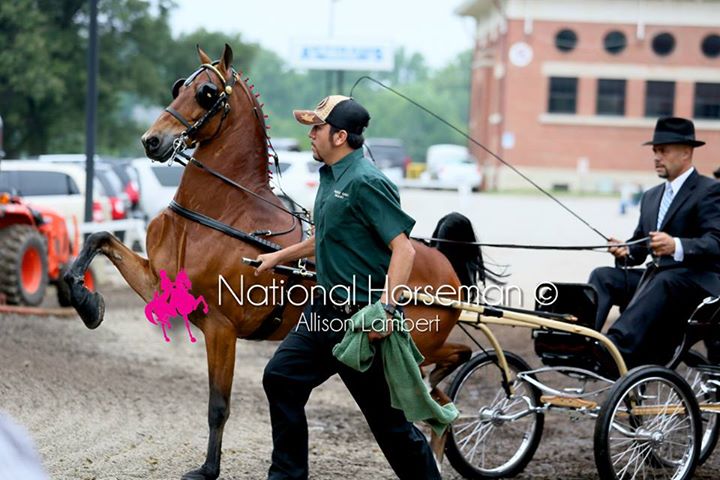
Louisville week has begun and we are all exhausted already! We’ve been up early and up late every day to see every single class on the schedule and hit every exhibitor party there is because it’s Louisville week! Well let me tell you who is 10x more exhausted than you can even imagine: your grooms! Here are five things you need to know about what it means to be a groom this week.
1. Exhaustion, Exhaustion, Exhaustion
Sleep's going to be minimal for a groom at any show. But this is especially true at Louisville, as the show happens to be a full seven days, instead of the usual three or four. This means that your grooms have actually been there for more like 13 days to get the stalls set up, and to get the horses there and settled before it all begins. That also means they are going to be running on an average of two to four hours of sleep - two for a normal day, and four on a slow one! Their level of exhaustion is incomprehensible. It’s like… stupid tired. It’s the kind of tired where you fall asleep if you lean on something solid (even standing). It’s the kind of tired where you occasionally don’t know if you are awake or dreaming!
2. Nutrition Is OUT The Window
Not only are your grooms exhausted - their access to healthy, nutritional food is very limited, and they'll very rarely have the actual time to MAKE food if they have brought healthy food with them. This week is a grab-and-go for EVERY meal kind of week, and that means eating a lot of fair food. If you recall that day or two when you head to your local county or state fair and eat the fried, greasy crap that we all love to have every once in awhile, remember how TERRIBLE you feel afterward because it’s just plain unhealthy (delicious, but unhealthy). Now imagine eating only that for the entire show week (including a few days before), while functioning on minimal sleep and working a physical job in the summer heat.
3. Sleeping Conditions Suck
One of the biggest causes of exhaustion is the fact that your grooms are keeping your tack and your horses safe by sleeping in a sleeping stall AT the stables. That’s right, no comfy hotel room bed with a continental breakfast (see above), but a stall, hopefully with a little plastic for the floor and for the ceiling (as a barrier against bird poop), and hopefully a mobile air conditioning unit. And even in the event they've got all these things, they're still sleeping in a barn.
4. Before, During, And After Care
Your grooms are spending countless hours clipping, sanding and polishing feet, washing legs, washing tails, and putting braids in just to prep for the show. They then spend at least 30 minutes brushing up and getting your horse ready for your class, making sure you have the perfect saddle pad, your saddle and bridle are spotless and your horse has all the little things they need (including THEIR road boots - if they need them - and a candy before they get their bridle on). They delicately and expertly put in their tail switches and braces (if needed), bridle and walk the horse until your moment has arrived. When it does, they help you on, wipe you down and ensure your pants are rolled down and clean. They then take absolutely EVERYTHING their hands and pants pockets can hold in terms of extras and what-if items to ensure that nothing is out of place for you and your horse and before you head in, they drop your tail, wipe down your horse, and wipe you down one last moment to ensure you are SPOTLESS for your moment. Finally when you come out, no matter how your ride went, they will take your horse back to their stall, bathe and hot walk them, brush them up and put them to bed with a pat, a candy, and maybe even if a kiss if they groom like I do. The list of to-do’s on show days go on and on and on and this isn’t even the half of it!
5. They Love Your Horse As Much As You Do
Grooms love their horses. Their string means the world to them. They take pride in their group of horses and they want them to be perfect for you and for the world. When you win, they win. When your horse is hurting, they are hurting. And when your back is turned after giving your horse peppermints and you have headed back to the front of your aisle to socialize, they are telling your horse how great they were today and how beautiful they looked (they are also definitely giving them more candy).
So while we think WE are tired from all the fun and that WE work hard to get to all the exhibitor parties, take a moment to really appreciate your grooms and ALL they do to ensure your experience is the best of the best. Little things make a big difference like showing your gratitude with a “Thank You” whenever possible, bringing around fresh fruit and vegetables whenever possible, and contributing ice and drinks to the barn cooler for them. And if you are lucky enough to win some roses, consider giving some to your groom for their own shadow box… believe me - the ribbons you forgot to pick up from last year’s big shows are hanging in their room with a photo they printed off. A rose would make all the difference in the world.
Photo from National Horseman, used with permission.
Green Shavings and Gratitude August 18 2015 1 Comment

The Kentucky State Fair World Championship Horse Show is the pinnacle of saddle seat showing events. From the distinctive green shavings to the decorated golf carts, the whole week is just an experience. Not only does this show hold the incredibly exhilarating and historical Five Gaited World Grand Championship, but it holds countless, stacked to the ceiling worth of talent, classes for the best of the best OF THE BEST! It’s one of the longest, hardest, and most amazing shows to witness, but here’s the thing: Each year, thousands of people enter their horses to compete in the week long show hoping for a chance at roses, and not everyone will get that opportunity.
Here’s where the gratitude comes in.
While we all have dreamed of winning the roses, and we’ve even dreamed of “just” winning our qualifier, we won’t all be so lucky. And that's OK. Part of the beauty of Louisville is that it is the ultimate example of “it’s not the ribbon, it’s the ride” (our favorite saying). Knowing that you are in the ring with a large number of the best equine/person athletic pairs, all competing for the same dream, and knowing that you and your equine partner can be counted among them is a blessing in itself.
This year at the World Championship Horse Show, take a look around you. Warm up in the ring and take your walk down Stopher’s Walk. Let your heart swell with pride for the sole reason that you are there and you are a part of it. Listen to your trainers and do your best, but when all is said and done, and your gate is open, your class is called and you hit that ramp with the green shavings and the air conditioning slaps you in the face, just let it wash over you. Ride the hair off of your horse. Take all of those lessons, all of those saddle sores and all of those moments of self doubt and be better. Find the best version of your equestrian self and present it to the world with your four legged friend. You are prepared and so is your equine partner so be a team and show everyone what you can do. When you finally come to the line up, let the gratitude fill you up. You did your best, you gave it all you got and if that’s what you walk away with, that is a win in and of itself. If you walk away with a ribbon, even better. And if you are one of the few that are lucky enough to walk away with a blue, revel in that moment and never forget it.
Be grateful before your class. Be grateful during your warm up. Be grateful for your class and be grateful after. Grab a fistful of those green shavings and good luck!
Have any memorable Louisville stories? Share them with us in the comments down below!
The Three Secrets to Surviving a One-Horse Class August 11 2015 2 Comments
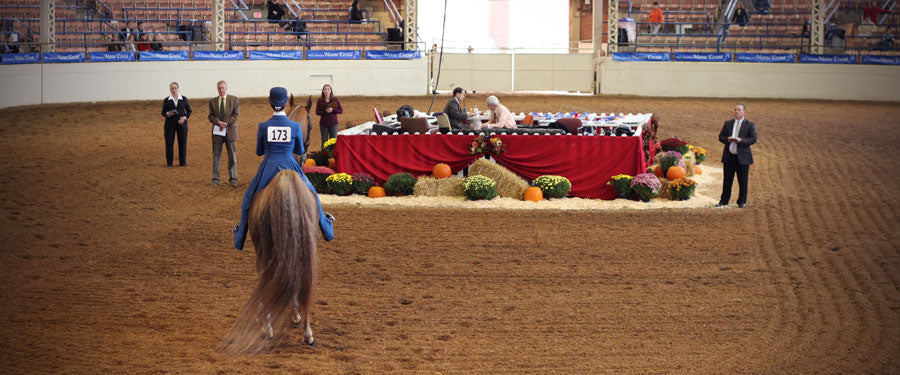
So you’re getting ready for your class when horse show management announces class numbers and you hear it…. “1 entry.” The exact number of entries no one wants for their class. Not only does it sort of suck because it’s an automatic win, but it also sucks because every single move you make will basically be trumpeted across the arena, because all eyes are on you! Well, while we should always be grateful for an opportunity to get in the ring, be it alone or in a class of 20, here are three tips to surviving the dreaded one-horse class.
Keep Calm
Getting too into your head about the fact that all eyes are on you will most likely throw your brain into fully loaded nuclear meltdown! Avoid this by doing some breathing exercises or following your regular horse show routine. Why should a one horse class be any different than a class of 20 in terms of your goals as an equestrian? It shouldn’t. So do your best to treat it the same emotionally!
Take it seriously
Even though you are basically guaranteed a win here, put as much effort into this as you would in a larger class. Don’t slump your way through the class and get sloppy because you know it’s in the bag. Treat each class, the horse show officials, and the spectators with the respect they deserve and put your heart into it! Just like you would in any other class. If being alone doesn’t make you nervous, don’t let being alone make you arrogant either.
Enjoy yourself
While we all love the thrill of making big cuts and passes down the rail, the thrill of a roaring crowd for a giant class of beautiful animals, this is a rare opportunity for you to showcase yourself and your horse when you KNOW people will be paying attention to you! After all, a show is a show is a show and we are in it for the learning, the equestrianism, and let’s face it, the little bit of glamour we all feel on the back of a show horse, so let your glamour flag fly and SHOW!
Have you ever had something go seriously wrong in a one horse class? Tell us about it in the comments down below!
The Life Skills We Learn From Horses August 03 2015 1 Comment
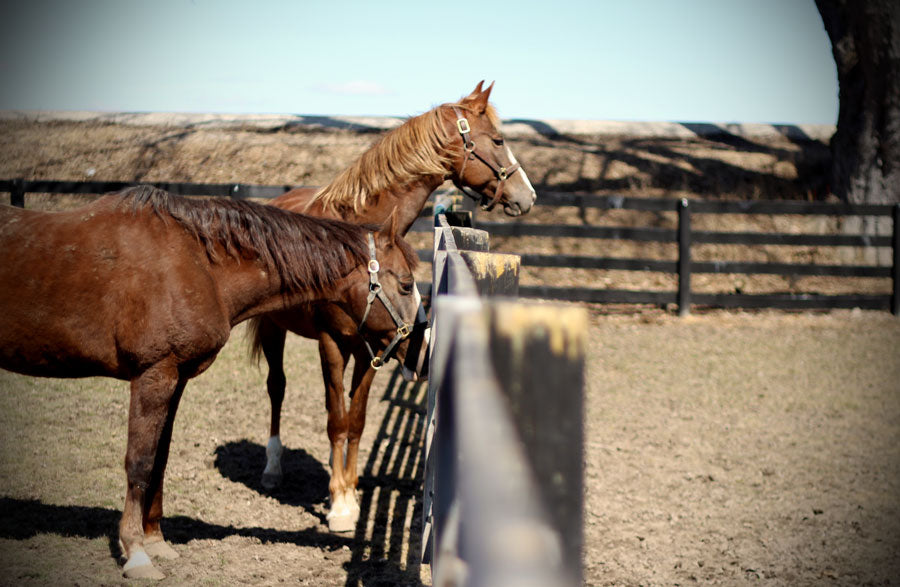
Recently, we've talked about the science that shows how equestrianism makes us physically healthier. But what about our emotional health? What kind of impact does equestrianism have on us as people?
Well, aside from that “gut feeling” we all get when we are around horses, there are some serious benefits in terms of the personal and emotional development of those of us that are lucky enough to spend time with horses.
Self esteem
The amount of responsibility you are given, be it at a young age or as an adult, when it comes to working with horses is incredible. Horses are disturbingly fragile for how established a species they are. It takes a lot of knowledge to understand things like when and how much water is needed, when to feed and what meds are needed, and when they need hot walking and recognizing that line between the “too warm to let loose” feeling and the “just right to let loose” feeling. Being able to keep a handle on these things and enjoy yourself does wonders for your confidence!
Not to mention that working collaboratively in a barn of other riders builds confidence! So despite (or maybe because) equine related work isn't glorious or glamorous - it’s usually a lot of poo picking up - it is undeniably good for the soul.
Physical activity
While a physical workout has clear benefits on the health and emotional side of things, people often disregard the other side of how physical activity benefits the soul. Exhaustion builds character and emotional strength as well as physical strength, because nothing like working through the burn of putting up a semi-truck full of hay bales will prepare you for the mind numbing pain of 8am lectures or 3pm staff meetings.
Empathy
Such an important thing to be able to feel and express in a world that is continually allowing us to become isolated from those around us, empathy is what keeps us connected! Nothing will teach you empathy like caring for a creature that has mood swings, just like people, and has a personality that you have to figure out in order to get along. It makes you think about their perspective and problem solve your way out of a bad spot using the powers of empathy. Needless to say there are BILLIONS of real world applications for an empathetic approach to problem solving and human relations.
Poise and grace in adversity and good fortune
We know we’ve said, “It’s not about the ribbon, it’s the ride” and “A blue doesn’t mean you’ve won” and any other number of phrases about winning and losing before, but nothing is a more important life lesson! Equestrianism teaches you that life is not fair. (AWWWW SHUCKS!)
No, but seriously it’s not…. surprise! Sometimes you win a class and you know you didn’t deserve it and that’s just as embarrassing as totally wiffing it and getting excused. Sometimes you definitely deserved to win and you didn’t even get a look. The point is, we must always win and lose with grace in any facet of life; be it with our equine teammate or at work or in school!
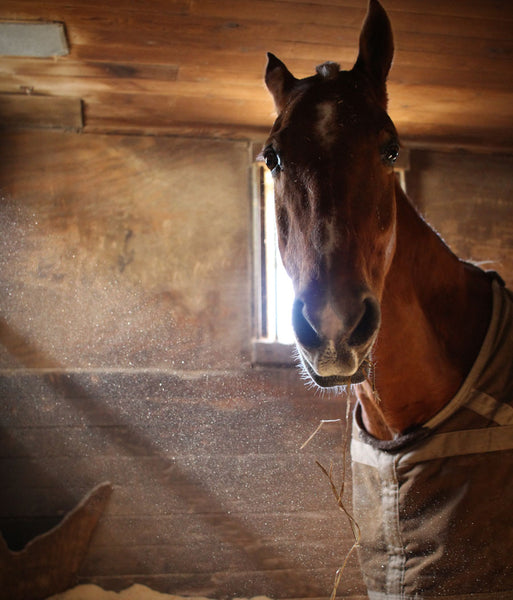
Love
Equestrianism, above all, teaches us to love unconditionally. Equestrians love an animal who’s whole heart is dedicated to pleasing (though sometimes we think they might be dedicated to messing with us). We love an animal that is, generally speaking, naturally terrified of virtually everything we ask it to do, but has learned to stifle that fear and trust over time that you, the equestrian, will keep them safe. We love an animal that is quadruple our size, but would often really like to sit in our laps… if accomplishing that snuggling position were easier to assume.
Equestrianism teaches us how to express unconditional love with such aggressive fervor that you can’t help but grow to be the type of person that knows life is better with that type of love than without it! (I mean… the last time you let someone brush your horse and they didn’t get rid of all the saddle marks, you drove to their house and made them run all the way back to the barn to redo their crap grooming job….. right? or was that just me…)
Did we miss any important life skills you learned from being an equestrian? Let us know in the comments down below!
How to Survive a Hectic Warm Up Ring July 28 2015 1 Comment
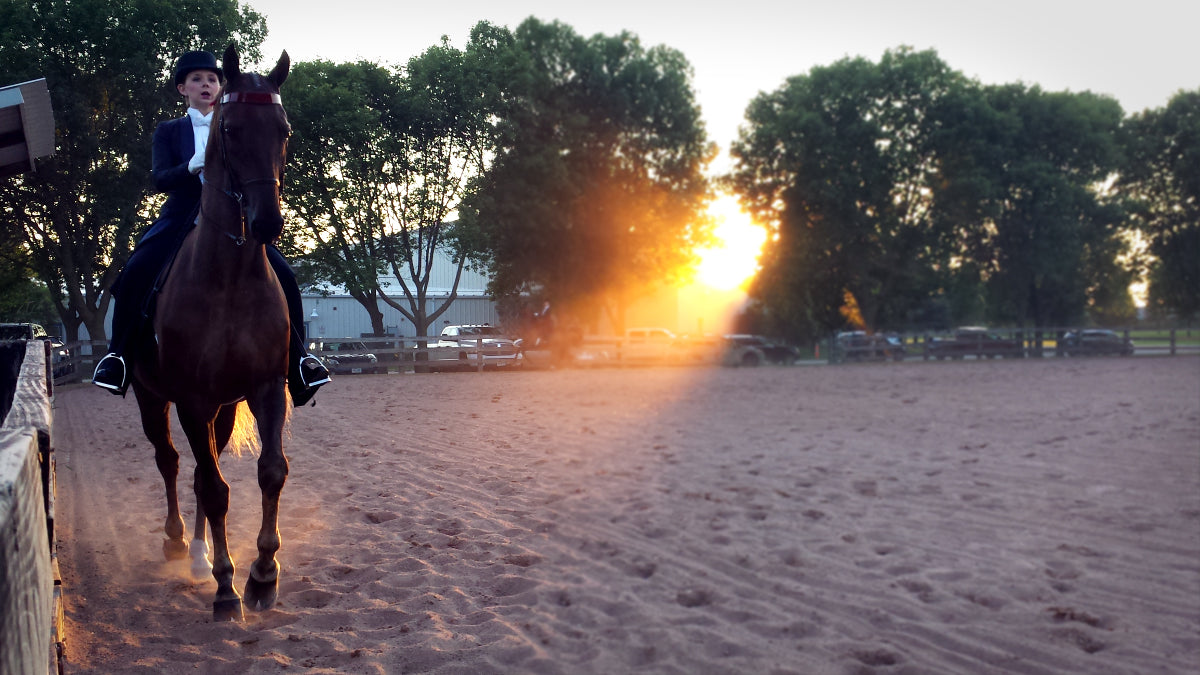
When it comes to getting you and your horse warmed up, your trainer is definitely the expert. They know when to get out there, if you need to get on first or if they need to get on first, and all the little details like whether or not you need to start out at the canter or just walk around for awhile. The one thing a trainer can’t help you with is the absolute CHAOS that rains down on you and your horse in the warm up with the forceful voices of like 10+ trainers yelling at their people and everyone going in different directions/doing different things. So, how do you keep up your side of the bargain by keeping it together through this mess? Here are five tips to surviving the most hectic of warm ups.
Listen
Probably the most obvious of all, if you aren’t focusing on listening out for your trainer’s voice, not only are you going to have a hard time keeping up with their commands, but you are reaaaaaally going to irritate your trainer. Everyone wants to have a successful warm up, it sets you, your horse, and your trainer up for feeling confident in how the class will go. Nothing will give you and your trainer doubts like failing to pay attention, so keep your eyes and ears peeled. Everyone understands that it can be hard to hear in the warm up ring, so make sure you acknowledge that you didn’t hear them if that’s the case so they can adjust the volume of their commands, and even the timing to assist everyone.
Spatial Awareness
Key to staying alive in the warm up is spatial awareness. Just like in the class, finding your spot and “driving defensively” to maintain your lone wolf status is paramount to staying safe. The main difference here is when you are in the warm up not everyone is going in the same direction! So while you are listening out for your trainer’s commands keep looking around you to make sure you are in a good position to maneuver when and where needed. Another important aspect of this is to making a directional decision and sticking to it. That moment where two of you are on the rail coming at each other and you look each other in the eyes as if to say, “should I get off the rail, or are you going to?” Whatever the answer to that question is, do NOT do the “no you go, no you go!” dance…. it’s not pretty when two horses collide.
Courtesy
Little rules about where you should and should not be doing certain gaits can help with your spacing and self preservation. If you are walking, it is actually more courteous to stick to the rail. You will only be a severely slow speed bump to everyone around you if you are walking just off the rail; even if you are doing it with the intention of giving the other equine/human athletes their chance to do when they need to. Essentially, the slower you are the closer you either need to be to the rail, or the absolute middle of the arena (where all the trainers and grooms are) to be courteous and SAFELY out of the way of those still working on their warm up routine.
Stay away from the gate!
If you are in the warm up, it’s likely that at some point, some horses in that warm up ring will need to head into the arena for their moment! When that time comes, try to stay on the far end of the arena and avoid crossing in front of the gate. Not only does it make getting in the arena a bit like a game of Frogger for the competitors heading in, but also it puts you and your equine partner in a pretty compromising position, something no one needs before their class!
Thank your groom
So while you’ve been focusing on listening, spacial awareness, being courteous to the other competitors, and avoiding the in gate, your groom has been focusing on making you and your horse look LITERALLY perfect before heading in the ring. If it’s hot out, they are probably carrying your water for you, maybe even an ice pack or two to pop in your hat just before you enter. They might even be carrying your coat, stirrups, whip, a ladder, any number of items meant to make your experience better and as seamless as possible. Toss them a “thank you” as often as possible because without them, your warm up, your show, and your show prep would be just another thing for you to worry about! And you already have plenty to focus on.
Have you had any crazy or amazing experiences in the warm up ring? What did you learn from those experiences? Let us know in the comments section down below!
What It Looks Like to Win a Five Gaited Show Pleasure Class July 13 2015
I have very little sense of what it’s like to successfully ride in a Five Gaited Show Pleasure Class. My riding looks far from pleasurable for any party involved, as I flop around like a wet noodle. Luckily, a far more talented and less noodlesque rider than myself wore a GoPro at the Oshkosh Charity Horse Show a few weeks ago, so I could get a better sense of what the experience actually looks like.
The talented rider (and great sport) who wore the GoPro for was Abby Kastenholz from Knollwood Farm, and the horse she was riding was Ch Freaky Links, a world and national champion with many wins against great horses. Between editing all the footage and being at the show, there were a few things that really stood out to me.
- I have a newfound respect for just how much strength and balance it must take to rack. Racking must really feel like you're flying. Either that, or hanging on for dear life. There's just so much movement happening when a Saddlebred goes into a rack, I have no idea how anybody could control it.
- It must take a ton of composure to stay calm in a big class, both for the horse, and for the rider. Watching a class from the rail, it always feels like there's a lot of space between horses, but watching from a rider's perspective, even through a fisheye GoPro lens, you realize just how much traffic there is to sort through in a class of ten horses.
- There's a lot that goes on behind the scenes. While I typically think of a class of 10-15 minutes long, there's a lot of getting ready, getting your horse dialed in, and getting your nerves under control that I'd never really considered.
At The Jodhpurs Company, we believe that riding is a sport, not a hobby. But so often, as a spectator at a horse show, it's easy to watch talented riders make it look like a piece of cake to keep a big, strong and easily excited and frightened animal under control. It's awesome to get a sense of how much work actually goes in to riding such an amazing and powerful horse from the rider's point of view.
What did you think of the video? And what surprised you at your first show? Let us know in the comments down below!
Workout Wednesday: A Quick and Dirty Equestrian Leg Day July 08 2015
Why bother?
If any group of people need to make sure they don't skip leg day, it's equestrians. Unfortunately, life often gets in the way, which means you'll occasionally spend a few weeks without having a chance to ride. After as little as two weeks off, however, your muscles can begin to atrophy and your strength will slip. Which means that when you get back on your horse, you'll not only feel rusty, but the muscles in your legs and back will be weaker for the time off.
So here's a quick and dirty leg day workout you can squeeze in around whatever you're doing, no matter where you happen to be.
How do I do it?
Follow this simple and awesome workout from Neila Rey.
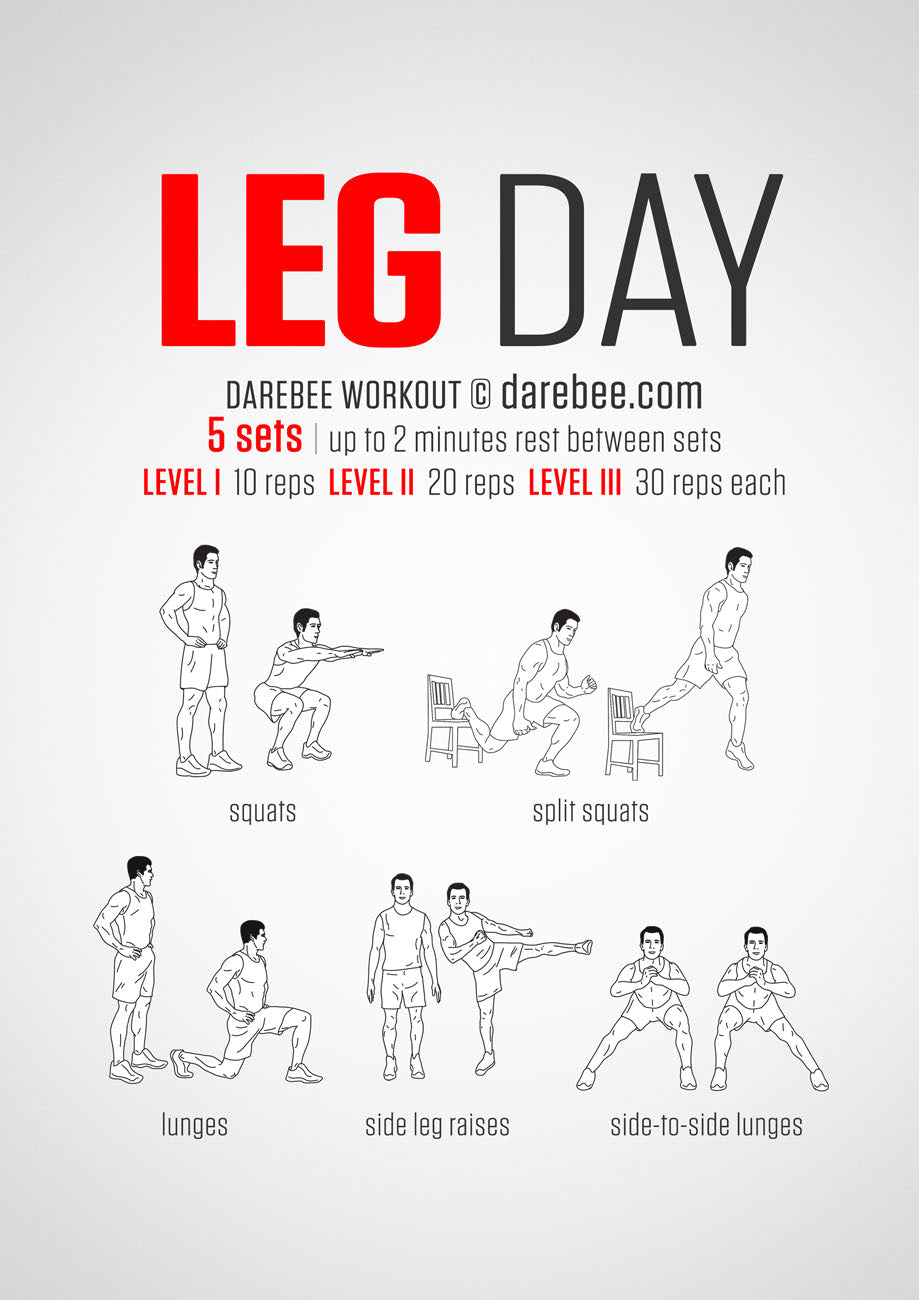
Tip: if you want to put a twist on it to help you maintain the inner thigh strength you need for gripping your horse, then switch out the set of squats at the beginning for plie squats:
When do I do it?
This is a great standalone workout (following a warm up), or you can do it at the end of a strength training session.
The Three Secrets to Success in the Lineup July 07 2015 2 Comments
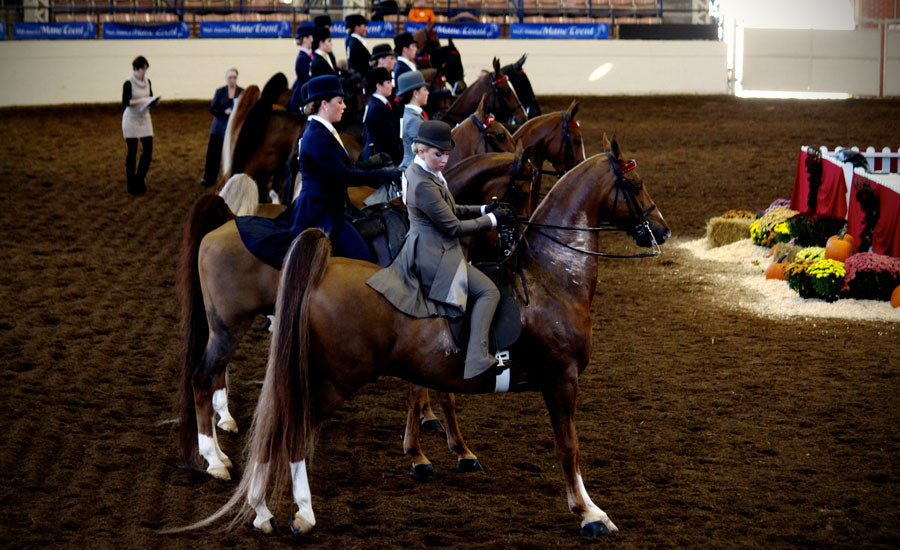
So you’ve just managed to do all three gaits in both directions without a single hoof out of line, when over the PA you hear “Now riders we ask you bring your horses on in and line up!” WOOO! Sigh of relief! Class is over and you made it out alive, right? Wait… the class isn’t over? That’s right, it’s not. If you are in any pleasure division, the class isn’t over till the fat lady sings (or until the judges cards are in). Not only do you have to back, but you actually have to stand calmly in the lineup. Pretty daunting, but here are four tips to help you make it through the worst five minutes of any pleasure class: the end!
Loosen up on your curb
While your horse may require an absurd amount of curb rein to wear their head throughout the class, if you maintain the same level of curb for the lineup, you will be asking for trouble. Not only will this pull your horse’s head down between their knees (because forward movement is what allows us to USE our curb effectively and they are hopefully standing still in the lineup), but it will probably get them pretty irritated. So just do yourself and your four legged team mate a solid by just letting that curb rein slip through your fingers a bit while you stand there.
Don’t over park out your horse
We get the whole “down - tap” ritual that your trainer always runs through with you at the end of your lessons, but you should be careful not to let your horse get over parked. Doing so can be hard for them to maintain physically, and also bad for their back. If they square up and take a couple steps outward to park out, that’s good enough. The point of the “down-tap” is so that the horse understands they standing, not waiting for a cue to do something entirely different.
Keep them occupied
Whether it’s telling them how freaking amazing they were, scratching their neck or actually poking them as if to say “hey…. hey you!” do something to keep your horse occupied because the reality is, a lot of horses, while perfectly great at standing, may end up next to a horse that isn’t and may prefer to take their cues from that horse. Or maybe today just isn’t their day. Who knows! The point is, just like when you ride, you should be keeping your focus on your horse and getting them to focus on you!
When it comes down to it, there is only so much you can do when the bugs are really bad, the other horses in the lineup are misbehaving/ramming into you, or the speakers start to bug out and play the organ music in choppy, explosive intervals that are terrifying to you AND your horse. All you can do is keep control of yourself and the things you can directly affect, like above mentioned items!
Have any tips for staying still in the lineup? Share them with us in the comments down below!
How Horses Make Humans Healthier June 28 2015 6 Comments
If you're a horse rider, you certainly know that horses make you happier. But did you know that they also make us healthier? From the natural high feeling you get after a ride, to the surprising number of calories burned in a day at the barn, riding and working with horses has astounding impacts on our health. Let's take a look at a few of the ways that horses are good for humans.

Share this Image On Your Site
Horses Increase Our Empathy
One of the most surprising things that horses do for us is that they literally make us better people, by increasing our empathy. The science behind this is pretty amazing. As humans, our feelings of empathy are linked to a brain chemical called oxytocin. Interaction with all animals increases our oxytocin levels, but this is particularly true of horses, because they're so dependent on our training. As any riders know, working with a horse so they understand our verbal and physical cues isn't just a process of training your horse, it's a mutual process where you learn to understand each other. And that fills your brain with natural chemical goodness.
Of course this isn't the only good chemical that your brain releases to say "good job" when you're done riding. In the same way as runners experience a natural "high" after a run, riders experience a "riders high" thanks to the endorphin release that follows a ride.
Riding is an Awesome Workout
Anyone who's gone full wet-noodle at the end of a tough ride knows this, but it's surprising just how amazing riding is as a workout. In terms of cardiovascular and calorie burning benefits, riding at a canter does twice as much as going for a brisk walk. Oh, and it's also literally a full-body workout.
Riding is Great for our Self-Esteem
Many equestrians really fall in love with the sport when they need it most. Often, that's during (or just before) adolescence, a time when our self-esteem tends to be at its lowest. Riding, caring for horses, and the social environment provided by a barn has been shown to improve self-esteem significantly, and reduce levels of the stress hormone cortisol.
What do you think, do horses actually make us healthier? And did we miss any ways that horses improve our mental or physical health? Let us know in the comments below or over on Facebook.
- Page 1 of 3
- Next

